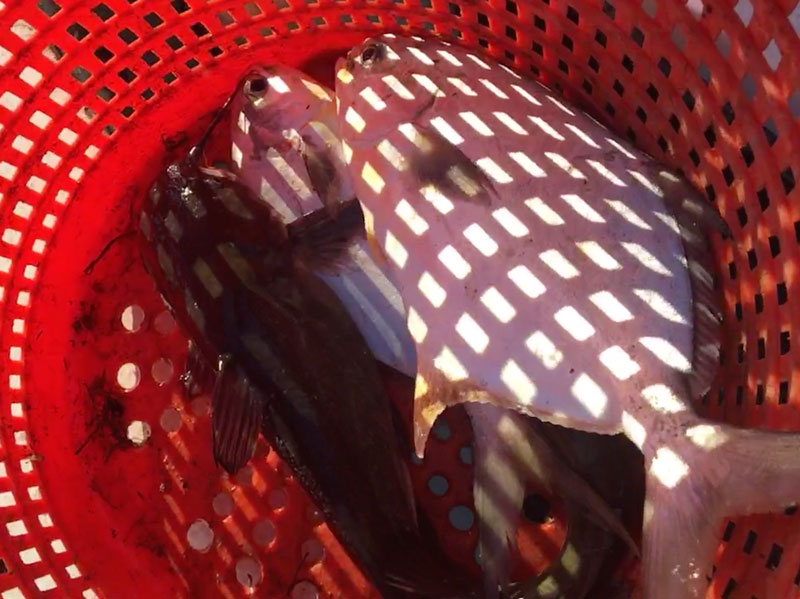Pound nets are found throughout the Chesapeake Bay waters – every time you drive past those lines of poles with nets hanging from them, you’re going by a pound net. Commercial fishermen use the nets to capture finfish to sell on the market, bringing fish to your local restaurant and bait to your tackle shop. Striped bass, catfish, carp, menhaden, and perch are a few of the species that these fishermen typically target between April and November. I was given an opportunity to go out with Maryland DNR this past June to survey a few of the nets and I didn’t hesitate to say yes. I was picked up at 5:45 in the morning for the drive down to Point Lookout State Park. Once there, we readied ourselves by putting on our waterproof bibs and rubber boots, launched the boat, and took a short trip out on the Potomac River. There we met up with the fishermen at their nets, where they had already started their harvest.

The net is made up of three parts. The first is the hedging, which guides the fish from the shoreline into the second section of the setup, the heart. This section of the net funnels the fish into the third section of the net, the pound. Here the fishermen will collect their catch.
Using a large dip net, they remove the fish from the pound and place them into baskets. They would normally separate out and release undersized fish and bycatch at this time, but today they transferred the fish to our boat. The fish were then placed into a holding tank that’s oxygenated and treated with salt. We measured the length of the striped bass and recorded the information, noting if the fish had any lesions or other disease. Fish under 18 inches were released, as well as any fish that had lesions regardless of size. The healthy and legal-size fish were returned to the fishermen.
We also removed a few scales from selected fish of various sizes so that the DNR could age those fish, back in their lab. This process helps with their age-length key. The process doesn’t harm the fish since scales replenish themselves, similar to the way your hair does.
The data collected is used by the DNR, as is the data collected during their spring adult spawning stock survey. I was fortunate enough to go out on one of the gillnet surveys earlier this year, too, when we collected the same type of data, sexed the fish, and tagged them. In cooperation with United States Fish and Wildlife Service, the fish are fitted with an internal anchor tag. These tags are used to evaluate the spawning stock and their migration along the Atlantic Coast.
The purpose of these surveys is to characterize the size, age, sex, and maturity stage of striped bass within the respective surveys. The data collected is reported to the Atlantic States Marine Fisheries Commission in the annual Compliance Report. This data is then used by the commission to manage the striped bass fishery.
As recreational fishermen we benefit from the data collection as well. The data is used to access the breeding stock and summer and fall stock of striped bass in the bay and its tributaries. Most importantly, the data is used to set regulations on this fishery, to protect it, and provide us a healthy and viable fishery.
You can find more information on the results of these surveys at the DNR website.
Pompano, in the Chesapeake?!

As you may suspect, gill nets and pound nets collect non-targeted fish. What was surprising to me is the variety of these fish, some of which the fishermen will keep and sell on the market, too. They may keep and sell legal size crab, catfish, sea trout, puffer fish, mackerel, and even pompano. There are pompano in the Bay?! Our catch in the Potomac pound net proves it beyond any doubt.
- By Eric Packard